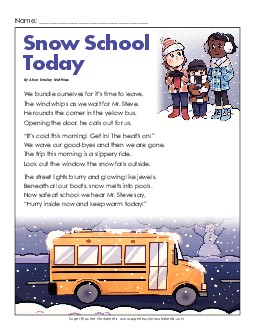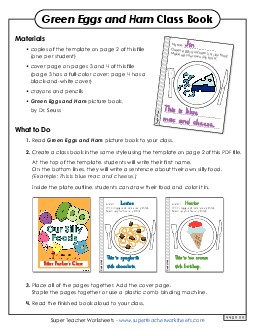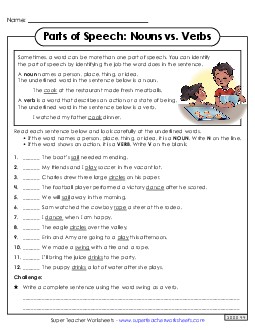English - Language Arts Worksheets

Read the article, poems, and stories, and answer the reading comprehension questions. Passages written for students at a first grade reading level.
2nd Grade Reading ComprehensionRead the stories, poems, and articles. Then answer the reading comprehension questions. Passages written for students at a second grade reading level.
3rd Grade Reading ComprehensionRead the poems, stories, and articles. Answer the reading comprehension questions. Passages written for students at a third grade reading level.
4th Grade Reading ComprehensionRead the article, poems, and stories, and answer the reading comprehension questions. Passages written for students at a fourth grade reading level.
5th Grade Reading ComprehensionRead the article, poems, and stories, and answer the reading comprehension questions. Passages written for students at a fifth grade reading level.
AbbreviationsThis page has worksheets on abbreviations. Includes days of the week, months of the year, titles, streets, and states.
AdjectivesTeach students about adjectives that describe nouns.
AdverbsExplore adverbs, words that describe action verbs.
Alphabet WorksheetsTeach students to recognize, read, and write letters of the alphabet.
Alphabetical OrderWord sorts, cut-and-glue activities, and worksheets for teaching alphabetical order.
AnalogiesBuild vocabulary skills with these analogy worksheets.
Articles (A, An, The)Printables related to the articles a, an, and the.
BiographiesRead biographies of notable people in these nonfiction articles geared for elementary-aged students.
CapitalizationLearn to use capital letters for proper nouns and at the beginning of sentences.
Cause and EffectLearn about cause and effect relationships.
Chapter Books (by Title)We have worksheets and activities that can be used with popular titles in children's literature. If you read chapter books in your classroom, take a look at this page.
CommasThis page has a variety of printable worksheets for teaching students to use commas. Includes commas in a series, commas to offset non-essential information, commas in dates, and commas in addresses.
Compare and ContrastPrint Venn diagrams, compare/contrast worksheets, and compare/contrast reading passages.
Compound WordsBuild compound words by combining two smaller words together.
Conjunction WorksheetsUse these worksheets for teaching students about joining sentences or phrases with conjunctions.
ConnotationsLearn to identify words with positive and negative connotations using our printable connotations worksheets.
Contraction WorksheetsPractice making contractions by joining pairs of words with an apostrophe.
Cursive Handwriting PracticeMaster the art of cursive handwriting with these handwriting worksheets.
Diagramming SentencesCreate diagrams of simple and complex sentences with these worksheets.
Dictionary SkillsLearn to use a dictionary with these printable worksheets.
Double NegativesTeach students how to identify, and avoid, double negatives in their writing.
Fact and OpinionDetermine which sentences are facts and which are opinions.
Fairy TalesTry these fun fairy tale-themed activities with your class.
Friendly Letter WritingLearn to write a friendly letter with a date, salutation, body, closing and signature.
Grammar WorksheetsReview parts of speech with these grammar worksheets.
Graphic OrganizersOrganize, sort, plan, and classify with these graphic organizer worksheets.
Greek and Latin Word PartsCheck out our worksheets on Greek and Latin prefixes, affixes, and roots.
Greek MythologyPrintable puzzles, charts, reading comprehension passages, and worksheets on Greek deities.
HomographsHomographs are words that are spelled the same way, but have different meanings. Sometimes they also have different pronunciations.
Homophone WorksheetsLearn about homophones, words that sound alike but have different meanings.
HyperboleHave your students practice using hyperbole to improve their creative writing skills.
IdiomsIdioms are common phrases whose meanings are not taken literally. These worksheets teach students about some of the most common idioms in the English language.
InferenceLearn about inferencing with these printable worksheets.
Main IdeaLearn to identify the main idea in reading and writing. Includes graphic organizers and short reading comprehension paragraphs.
Middle School Reading ComprehensionRead the passages and answer the reading comprehension questions.
Mini-Books: Very Basic ReadingLearn to read with these basic mini-books for kindergarten and first graders.
Noun WorksheetsLearn about common and proper nouns, plural and singular nouns, and identifying nouns.
Nouns (Possessive)Learn to write plural and singular possessive nouns with these printable activities.
Parts of Speech (Mixed)Students identify the correct part of speech for given words within sentences.
Phonics: ConsonantsRecognize consonant letter sounds with these printable worksheets and games.
Phonics: Long and Short VowelsRecognize long and short vowel sounds with these activities and worksheets.
Phonics: Consonant BlendsThis page will connect you to over a hundred worksheets on two-letter and three-letter consonant blends. (examples of blends: br- is a blend for brain and bread; cr- is a blend for crab and crib.)
Phonics: R-Controlled VowelsR-controlled vowel sounds include /är/ as in car, /ôr/ as in horn, /ûr/ as in her, /âr/ as in hair, and /îr/ as in deer.
Phonics: Ch and ShLearn how to recognize and read the /ch/ and /sh/ digraphs with these printables.
Phonics Word WheelsPractice reading words from a variety of word families with these phonics word wheels.
Poems for KidsPrint dozens of fun and creative poems for kids of all ages. Most poetry pages include comprehension questions.
Poetry WritingLearn to write haiku, acrostics, couplets, and more with these poetry writing worksheets.
Prefix - Suffix WorksheetsWorksheets that can help you teach root words along with basic prefixes and suffixes.
Prepositional Phrases WorksheetsLearn about prepositions and prepositional phrases.
Proofreading ParagraphsRead the paragraphs and correct the mistakes using proper proofreading marks.
Punctuation WorksheetsUse question marks, periods, exclamation points, commas, and quotation marks properly.
Printing (Handwriting) PracticeMaster the art of printed (manuscript) handwriting with these practice sheets.
Pronoun WorksheetsRecognize and understand proper pronoun usage.
Question WordsPractice basic question words with these worksheets. The six words are who, what, when, where, why, and how.
Quotation MarksThese printables can be used for teaching students to use quotation marks in their written dialogue.
Reading & Literature Circle WorksheetsUse these printables for reading groups, book clubs, and lit. circle time.
Reading Comprehension WorksheetsRead the passages and answer the comprehension questions.
Reading - Animal ArticlesDiscover new facts about your favorite animal species.
Readers' Theater ScriptsRead interactively with these fun Readers' Theater scripts.
Rhyming WorksheetsWorksheets for Rhyming words, matching, webs, and mini-books.
Sentences (Basic Building Sentences)The page contains basic build-a-sentence worksheets. Students cut out the word cards and rearrange them to make complete sentences. These worksheets were designed primarily for students in Kindergarten and 1st grade.
Sentences (Run-Ons and Fragments)Learn the differences between complete sentences, run-on sentences, and fragments.
Sentences (Simple, Compound, Complex)Learn about simple, compound, and complex sentences. Review the differences between fragments and run-ons.
Sequencing WorksheetsPrint sequencing strips, sequence worksheets, and sequencing graphic organizers.
Sight Word UnitsWe have a sight word curriculum that contains 30 units. Each unit has worksheets, practice tools, and assessment resources.
Sight Words (Individual Words)This page has over 150 individual sight words. Each word has several worksheets. (For example, you will find several worksheets just teaching students about the word the.)
Sight Words (Dolch Words)Review basic sight words with these Dolch flashcards, worksheets, and word wheels.
Sight Words (Fry Words)Review Fry Instant Sight Words with these flashcards, word wheels, games, and checklists.
Similes and MetaphorsWhen teaching figurative language or writing, you may want to try these simile and metaphor worksheets.
Spelling, Grade 1Build spelling skills with this set of resources for first graders; Includes word lists, puzzles, ABC Order sorts.
Spelling, Grade 2Build spelling skills with this set of printables for second grade teachers; includes lists, puzzles, and alphabetical order sorts.
Spelling, Grade 3Build spelling skills with this set of materials for third grade teachers; includes lists, puzzles, alphabetical order sorts, flashcards, and testing materials.
Spelling, Grade 4Build spelling skills with this set of printables for fourth grade teachers; includes lists, puzzles, and alphabetical order sorts.
Subject and Predicate WorksheetsLearn the difference between the subject and predicate of a sentence.
Syllable WorksheetsPractice dividing words into syllables.
Synonym and Antonym WorksheetsBuild vocabulary skills with these worksheets on synonyms (words that have similar meanings) and antonyms (words with different meanings).
Transition WordsThis page has resources that will help kids learn about using transition words in their writing.
Verb WorksheetsLearn all about action verbs and linking verbs.
VerbalsInfinitives, participles, and gerunds are called verbals. Verbals are verbs that act as nouns, adjectives, or adverbs.
Voice (Active and Passive)Practice differentiating between sentences written in passive voice and active voice.
Word FamiliesWord families are groups of words that have common endings (examples: hat, sat, at, rat; or back, pack, rack, sack, black). We have early literacy worksheets for dozens of different word families.
Word LaddersUse critical thinking and phonics skills to change letters in the given words to make new words.
Writing WorksheetsWrite sentences, letters, addresses, thank you notes, and more.
Writing Story Picture WorksheetsImprove writing skills with these story picture worksheets.
Writing PaperUse these printable sheets of primary and intermediate lines writing paper.
Writing Persuasive EssaysUse these worksheets when teaching students to express their personal opinions through persuasive essays.
Writing Prompt WorksheetsInspire students to write creatively with these printable writing worksheets.
Chapter Book Literacy UnitsHere you'll find a large selection of activities to use with the most popular chapter books. Titles include Tales of a Fourth Grade Nothing, Magic Treehouse, Charlotte's Web, Cam Jansen, The Boxcar Children, Bunnicula, and many others.
ELA BuzzThis spiraling set of daily review worksheets covers important ELA skills covered in most core curricula. From proofreading and punctuation to verb tense and vocabulary, these worksheets have a little bit of everything you want to teach your students about ELA
Fix the SentencesCheck out our full collection of daily Fix the Sentences worksheets, with content for grades 1 through 5.
Picture Book Literacy UnitsThis page has printable literacy activities to go along with poplar children's books. Titles include If You Give a Mouse a Cookie, Brown Bear, Brown Bear, What Do You See?, and many others.
Reading Comprehension WorksheetsBrowse the full collection of reading comprehension passages on this site.
Worksheet SetsBrowse by type of worksheet. This page has scavenger hunts, math crossword puzzles, mystery pictures, research projects, and more.



English Language Arts (ELA) is a fundamental subject in elementary school, covering a wide range of skills including reading, writing, listening, speaking, and comprehension. From kindergarten through fifth grade, students gradually develop these skills, starting with letter recognition, phonics, and basic reading comprehension in the early years, and progressing to more advanced topics such as writing essays, analyzing texts, and conducting research by the upper grades. Key areas of ELA include phonemic awareness, spelling, grammar, vocabulary, sentence structure, reading fluency, and narrative writing. As students move through the grades, they also learn how to express their thoughts effectively through speaking and writing while building critical thinking skills through reading and analysis.
In kindergarten and first grade, ELA instruction focuses on phonics, sight words, and basic reading skills. Teachers use interactive activities like alphabet games, read-alouds, and writing exercises to help students develop their early literacy. By second and third grade, students begin to read more complex texts and are introduced to basic grammar, punctuation, and sentence structure. They engage in activities like writing short paragraphs, practicing spelling, and answering questions about what they read to develop comprehension skills. In fourth and fifth grades, ELA becomes more analytical, with students reading chapter books, writing multi-paragraph essays, and learning how to summarize, infer, and compare ideas from different texts. Collaborative discussions and presentations also help students improve their speaking and listening skills.
Mastering the core concepts of ELA is crucial for overall academic success and communication. Strong reading comprehension skills enable students to understand texts across all subjects, while effective writing helps them convey their ideas clearly. Proficiency in ELA also fosters critical thinking, creativity, and problem-solving skills, which are essential in both school and life. As students progress through elementary school, Super Teacher Worksheets provides free learning tools and worksheets to help them build a solid foundation in reading, writing, and language use prepares them for middle school and beyond, where more complex texts and writing tasks become central to their academic journey.






